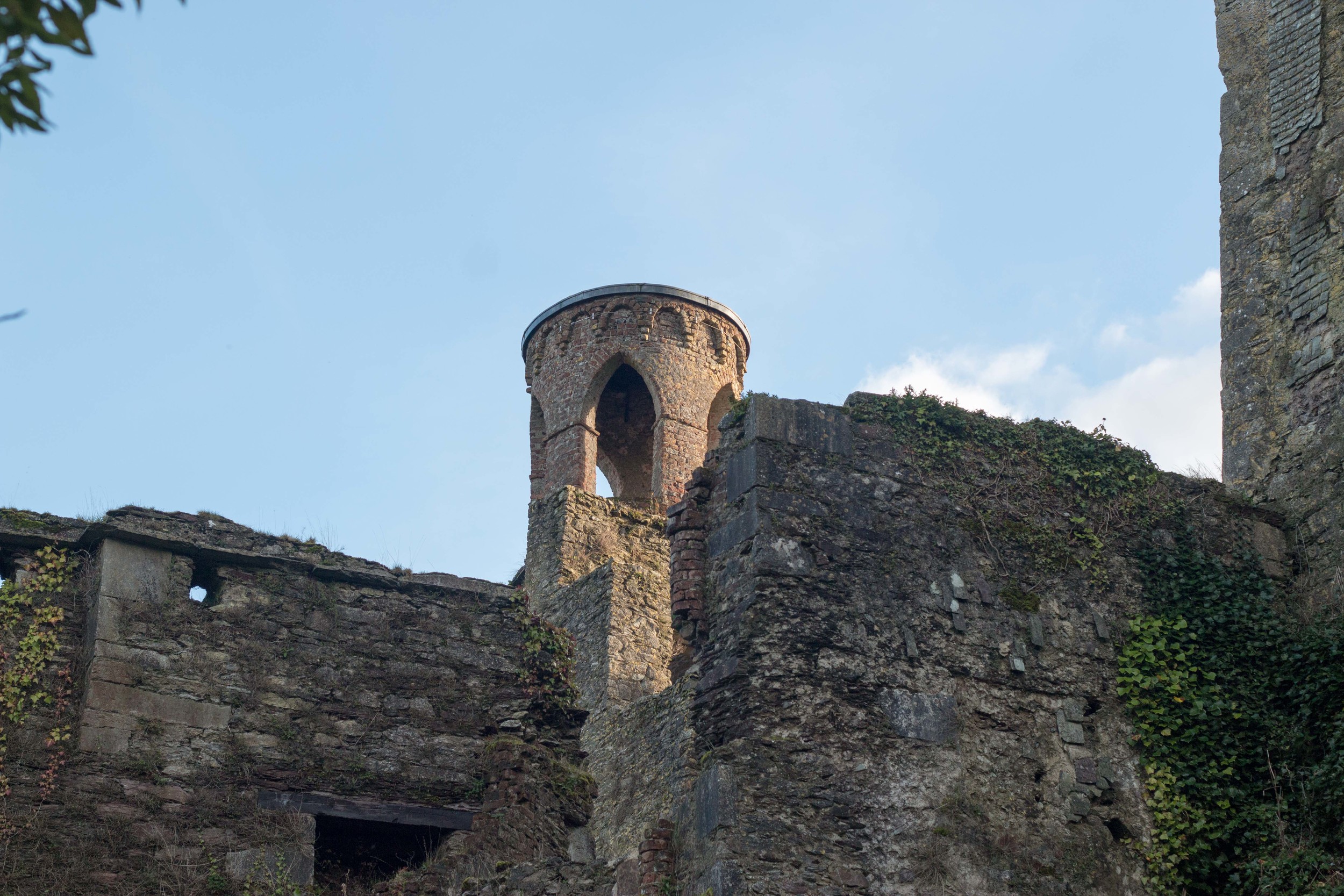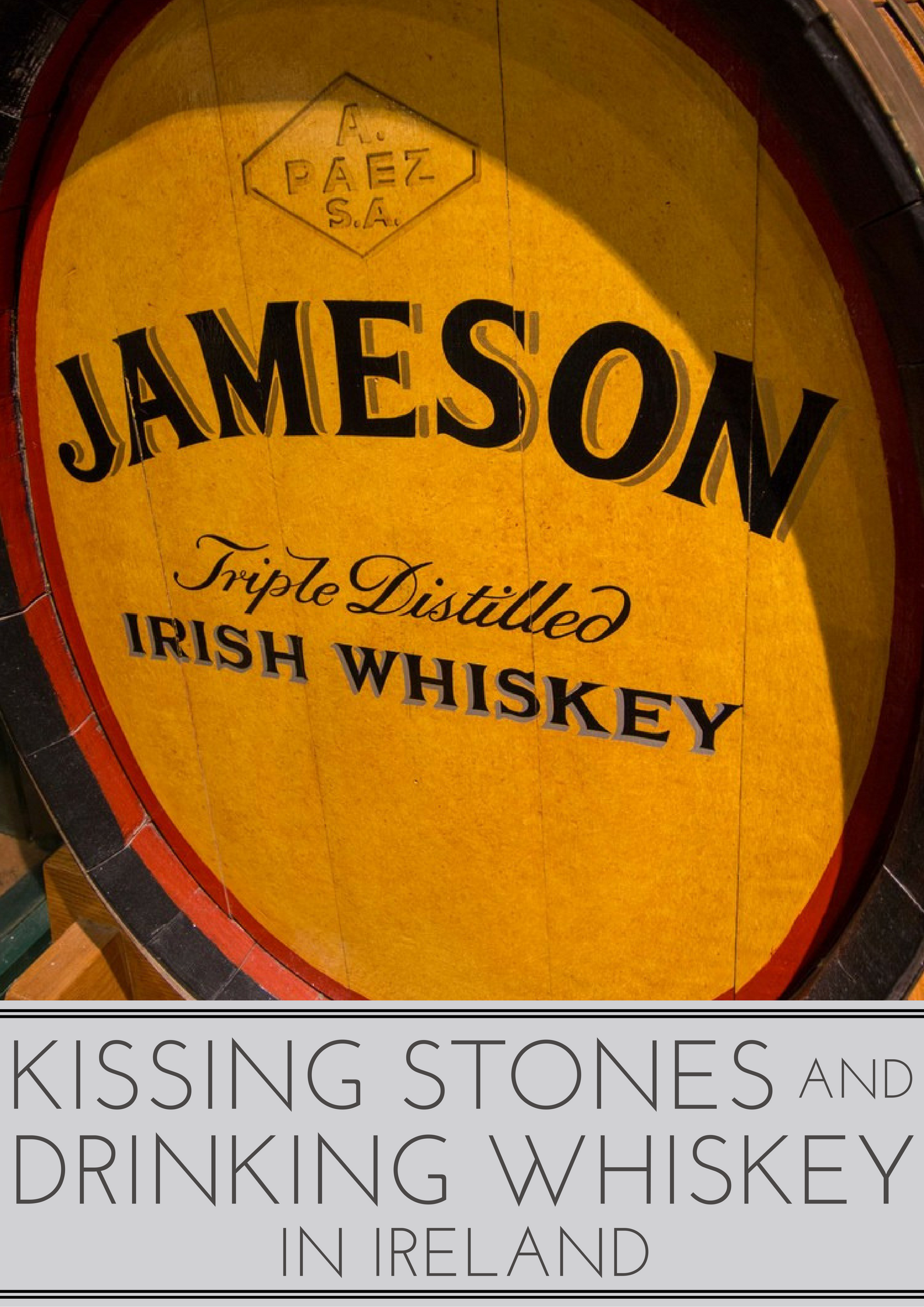Kissing Stones and Drinking Whiskey
/After our night in Limerick, we were on our way to Cork. Conveniently on the way is the Blarney Castle, with the world famous Blarney Stone. You know we had to stop for that! Turns out, it is in the town of Blarney and is much more than a castle with a famous rock. There are grounds, walking paths, and beautiful gardens. I bet in the summer, when it's in full bloom it must be gorgeous. Alas, we had to make do with the unique beauty, and relatively few tourists, of the winter season.
Watch tower in front of Blarney Castle
Blarney castle, as it stands today, was built in the 1400s by the McCormac family. In case you have never heard of the Blarney stone before, it is said that a person who kisses it is gifted with the gift of blarney (not to be confused with bologna). There are countless stories as to the stone's history that range from being the stone upon which Moses stuck his staff (click here for more information) to a stone originally from Ireland, that traveled to Scotland where it served as the throne for the first King of Scots, half of which was then returned to the family owning the castle by Robert the Bruce in the 1300s. Despite it's elusive history, the word blarney was coined by Queen Elizabeth when referring to her correspondence with the Lord of Blarney. His letters were eloquent and artfully crafted, but did not give her the answers she was searching for (mainly that the Irish should rule their own land, but that the land should, technically, belong to the crown), to which she exclaimed, ''Oh! He is just giving me a lot more Blarney!'' And thus, the term blarney came to mean a delightful embellishment of the truth, not matter how unsavory that truth may be. It does not mean flattery and telling white lies. Everyone from the Simpsons to Winston Churchill have kissed the stone over the years!
First view of Blarney Castle
Admission to the castle is 12 euro. A little pricier than similar attractions in Germany, but on par with those in Ireland. From the gate, a nice, easy 5 minute walk following a river through the grounds delivered us to the base of the castle. This is not the largest castle that we have visited, but it's still pretty impressive. Your first view is from the very bottom, looking directly up. Set upon a large rock, it is a very imposing structure. At the base of it, there are two old dog houses, and an entrance to a tunnel that was closed off long ago. Alas, there is still some remaining, and visitors are even allowed to enter to look around (despite it being wet, dark and small). In front of the castle, next to the river, there is also an old watch tower. Inside, you can see where the supports for the stairs would have been, but they have been missing, probably rotted out, for a long time now.
We then walked around the front of the castle to enter. At the base of the castle, the walls are 18 feet thick. Think about that for a minute. 18 feet. All made from rock. I can't imagine the labor that went into building this place! However, I think the best part of this castle is that they let you pretty much go where ever you want. There are rooms, some with signs explaining what it is/was, tunnels, passages, a narrow, spiral staircases. It was kind of like a playground for adults. I love wandering around old castles and this one was a great one to do that at. There are signs posted throughout the castle pointing you in the direction the Blarney Stone. For us this experience was pretty cool; to walk through the rooms, see the old fireplaces, the small windows in the thick walls, walk over the uneven floor and imagine what life would have been like here in the 16th century when the castle was still relatively new. The last bit of the castle you need to walk through is a tiny, incredibly narrow spiral staircase to get to the top of the keep. It was barely wide enough for me to fit through.
Kissing the Blarney Stone!
And then, time to kiss the Blarney Stone! This is slightly easier said than done. To kiss the stone properly, you need to lay on your back and then lean back over this gap, plenty large enough for a person to fall though, and then pucker up. Today, they have installed hand holds, as well as iron bars across the bottom, and have someone holding you legs to make it safer. The have also have a mat down to lay on (to keep your clothes clean) and a camera rigged up to capture the moment. From the top of the keep, you can get some incredible views of the Irish countryside before heading back down another spiral staircase (with a couple more areas to explore).
Beautiful Irish countryside. Aaron even let me take his picture!
Surrounding the castle are a number of gardens, the most interesting of which is the poison garden. The entire garden is filled with plants that cause everything from a mild upset stomach to death. Typically, the plants need to be ingested, but in a few instances, just touching the plant will bring on symptoms. There were plants that ranged from those found in Harry Potter (wolfsbane, mandrake) to more commonly known plants (nightshade, poison ivy) but they even included a cannabis plant in the garden. In medieval Europe, gardens like this were common and generally used to study and cultivate plants for medicinal purposes. After this, we headed out to our next stop, the Jameson Distillery!
The original Jameson distillery is in Midleton, about 15 minutes east of Cork. Although Jameson is no longer produced in the original distillery (it has since been moved to a much more modern facility next door). For the uninformed, the process for distilling was very interesting. The process is remarkably similar to beer brewing in fact. A portion of the barley is malted (soaked in water, drained, and then allowed to sprout) before being dried in a kiln. The malted barley is then ground, added to ground unmalted barley and maize, and brewed, similar to beer. The resulting mixture (mash) is then fermented with yeast (to convert the sugars to alcohol) before being triple distilled. The resulting spirits are then placed into oak barrels and aged. Irish law requires a minimum of three years aging to be called Irish whiskey, but most places let it mature for 12 - 18 years or longer. In many cases, almost 40% of the cask has evaporated after 12 years of maturing. The evaporated spirits are called the angel's share. I always thought that they used new casks for maturing of the whiskey. Nope, they often buy used ones that have held anything from Portuguese Sherry to American Bourbon. After the whiskey is matured, the master distiller chooses which barrels to blend together, and how much water to add, before bottling and shipping around the world. Some special barrels, they leave for further aging and later bottle them due to their unique characteristics.
Tools used to manufacture the barrels.
At the end of the tour, you receive a glass of Jameson whiskey and 8 people are selected to do a comparison tasting between Jameson, a scotch and an American bourbon. The main process is the same, but slight differences produce dramatically different products. These differences include; the maturation barrels, the way the malt is dried, how many times it is distilled, and how long it is left to mature. The one of these steps affect the way it tastes. Not being a huge fan of whiskey myself, I took my Jameson with ginger ale and lime (which was pretty tasty actually) and Aaron did the comparison tasting. He even got a fancy certificate indicating that he was a master whiskey taster (or something to that effect). Although, based upon their methods, I think just about everyone can be a master whiskey taster :)
We spent the night in Cork and found a little pub that served food upstairs for dinner. And they served craft beer. It was glorious. Germany's purity laws mean that they can brew the base beer well, but legislation prevents them from adding anything else to the beer that would create a more complex taste. In other words, no blueberry beer or cherry stouts in Germany (and most Germans are appalled at this idea - adding anything but barley, hops, yeast and water to beer is completely unthinkable). But the Irish don't have a purity law, and the craft beer scene in Cork is pretty big. We were drinking good Irish beer that night!
The next day we headed to Dublin, but not before making a couple of pit stops along the way at Rock of Cashel and the Smithwicks Brewery in Kilkenny. Check back for more on those two things!
- Meghan -
Linked up to:


























